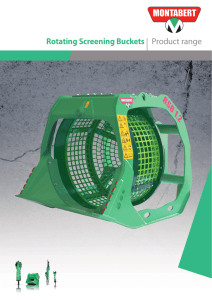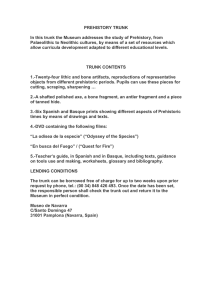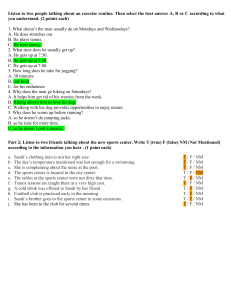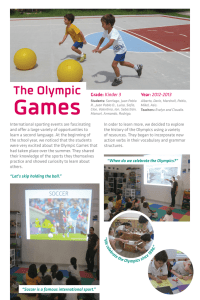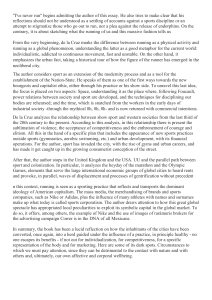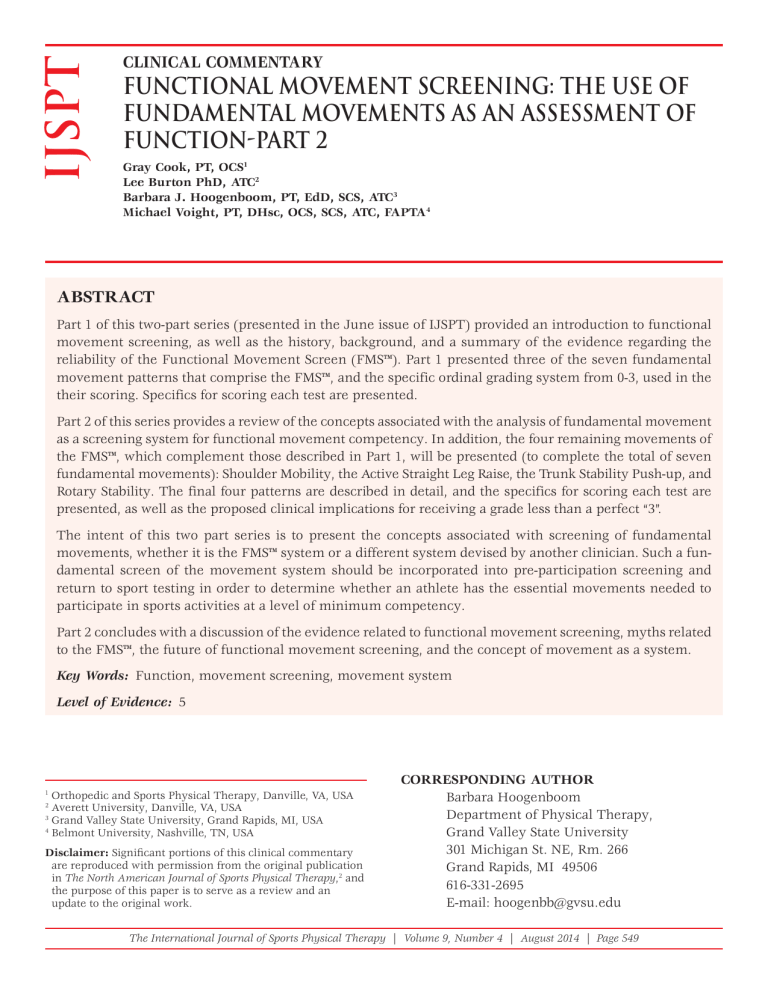
IJSPT CLINICAL COMMENTARY FUNCTIONAL MOVEMENT SCREENING: THE USE OF FUNDAMENTAL MOVEMENTS AS AN ASSESSMENT OF FUNCTIONPART 2 Gray Cook, PT, OCS1 Lee Burton PhD, ATC2 Barbara J. Hoogenboom, PT, EdD, SCS, ATC3 Michael Voight, PT, DHsc, OCS, SCS, ATC, FAPTA4 ABSTRACT Part 1 of this two-part series (presented in the June issue of IJSPT) provided an introduction to functional movement screening, as well as the history, background, and a summary of the evidence regarding the reliability of the Functional Movement Screen (FMS™). Part 1 presented three of the seven fundamental movement patterns that comprise the FMS™, and the specific ordinal grading system from 0-3, used in the their scoring. Specifics for scoring each test are presented. Part 2 of this series provides a review of the concepts associated with the analysis of fundamental movement as a screening system for functional movement competency. In addition, the four remaining movements of the FMS™, which complement those described in Part 1, will be presented (to complete the total of seven fundamental movements): Shoulder Mobility, the Active Straight Leg Raise, the Trunk Stability Push-up, and Rotary Stability. The final four patterns are described in detail, and the specifics for scoring each test are presented, as well as the proposed clinical implications for receiving a grade less than a perfect “3”. The intent of this two part series is to present the concepts associated with screening of fundamental movements, whether it is the FMS™ system or a different system devised by another clinician. Such a fundamental screen of the movement system should be incorporated into pre-participation screening and return to sport testing in order to determine whether an athlete has the essential movements needed to participate in sports activities at a level of minimum competency. Part 2 concludes with a discussion of the evidence related to functional movement screening, myths related to the FMS™, the future of functional movement screening, and the concept of movement as a system. Key Words: Function, movement screening, movement system Level of Evidence: 5 1 Orthopedic and Sports Physical Therapy, Danville, VA, USA 2 Averett University, Danville, VA, USA 3 Grand Valley State University, Grand Rapids, MI, USA 4 Belmont University, Nashville, TN, USA Disclaimer: Significant portions of this clinical commentary are reproduced with permission from the original publication in The North American Journal of Sports Physical Therapy,2 and the purpose of this paper is to serve as a review and an update to the original work. CORRESPONDING AUTHOR Barbara Hoogenboom Department of Physical Therapy, Grand Valley State University 301 Michigan St. NE, Rm. 266 Grand Rapids, MI 49506 616-331-2695 E-mail: [email protected] The International Journal of Sports Physical Therapy | Volume 9, Number 4 | August 2014 | Page 549 INTRODUCTION The purpose of movement screening using fundamental movements is to attempt to identify deficient areas of mobility and stability in the asymptomatic active population that may be overlooked with typical impairment-based testing.1,2 The ability to predict which athlete or active individual might become injured is highly relevant, and the authors believe, equally as important to rehabilitation professionals as the ability to evaluate and treat injuries. The difficulty in preventing injury appears related to the inability to consistently determine which athletes are predisposed to injury, despite knowing some of their risk factors. This difficulty has been illustrated in the large body of literature that addresses the contributing factors to ACL injury and subsequent attempts by researchers and authors to describe and implement prevention strategies. Algorithms and regression equations exist that attempt to combine risk factors3 in order to determine who may be at risk of sustaining an ACL injury, however, for many injuries and general disorders, such equations do not exist. Meuwisse4 suggested that unless specific markers are identified for each individual, the ability to determine who is predisposed to injury remains very difficult. The vast differences in utilization of many physical and performance tests during pre-participation or return to sport assessments illustrate the difficulty in identifying individuals at risk for injury. Although physical and performance tests are commonly reliable and have some level of normative data, they typically do not expose specific kinetic chain weaknesses. These two evaluation methods offer little insight into individualized fundamental movement strategies that affect the whole of sport performance. Numerous sports medicine professionals have suggested the need for specific screening techniques that utilize a more functional approach in order to identify movement deficits.4,5,6 The authors of this commentary suggest that the type of screening tasks that comprise the Functional Movement Screen™ (FMS™) may be a method of determining such markers that describe a “movement competency baseline”. The FMS™ is an attempt to capture movement pattern quality, and screen for movement competency in uninjured individual, using a simple, ordinal grad- ing system. It is not intended to be used for testing or assessment, but rather to demonstrate limitations or asymmetries with respect to common, fundamental human movement patterns. Tests and assessments are additional tools that can be used to further evaluate impairments of functional movements. The intent of the creators of the FMS™ was to develop a screen of movement that would expose functional limitations, which could in turn lead to an improved proactive approach to injury prevention.1,2 The FMS™ may be used in the pre-participation physical examination, or be used as a stand-alone screening system to determine deficits that may be overlooked during the traditional rehabilitation process, medical, and performance evaluations. In many cases, mobility, stability, strength, or neuromuscular control imbalances may not be identified during traditional screening and assessment. These problems, previously acknowledged as significant risk factors, can be identified using the FMS™. The movement-based assessment serves to pinpoint functional deficits (or biomarkers) related to motor control, mobility, and stability faults. Thus, this system could also be used at the end of the formal rehabilitation process in order to assist (along with strength, power, and functional performance tests when appropriate) in determining an athlete’s readiness to return to function. Scoring the Functional Movement Screen (FMS™) The scoring for the FMS™ was provided in detail in Part 1 of this series. However, the exact same instructions for scoring each test are repeated here to allow the reader to score the additional tests presented in Part 2 without having to refer to Part 1. The scoring for the FMS™ consists of four discrete possibilities.1,2 The scores range from zero to three, three being the best possible score. The four basic scores are quite simple in philosophy. An individual is given a score of zero if at any time during the testing he/she has pain anywhere in the body. If pain occurs, a score of zero is given and the painful area is noted. This score necessitates further assessment by the professional, and an alternate functional movement assessment system developed for patients with known disability, injury, or pain is called the Selective Functional Movement Assessment (SFMA). Although beyond the scope The International Journal of Sports Physical Therapy | Volume 9, Number 4 | August 2014 | Page 550 of this clinical commentary, the SFMA is a clinical assessment that is designed to systematically identify causes of movement dysfunction while taking pain into consideration, using an algorithmic approach.7,8 A score of one is given if the person is unable to complete the movement pattern or is unable to assume the position to perform the movement. A score of two is given if the person is able to complete the movement but must compensate in some way to perform the fundamental movement. A score of three is given if the person performs the movement correctly without any compensation, complying with standard movement expectations associated with each test. Specific comments should be noted describing why a score of three was not obtained. The majority of the tests in the FMS™ examine both the right and left sides in order to determine if symmetry is present or absent, and it is important that both sides are scored. The lower score of the two sides is recorded and is counted toward the total; however it is important to note imbalances that are present between right and left sides. Three FMS™ tests presented here in Part 2 (the shoulder mobility test, the trunk stability push-up, and the rotary stability test) have additional clearing screens that are graded as positive or negative. These clearing movements only consider pain, thus, if a person has pain during the screening movement, then that portion of the test is scored positive and if there is no pain then it is scored negative. The clearing tests affect the total score for the particular tests with which they are associated. If a person has a positive clearing test then the score will be zero for the associated test. All scores for the right and left sides, and those for the tests that are associated with the clearing screens, should be recorded (Appendix A). By documenting all the scores, even if they are zeros, the sports rehabilitation professional will have a better understanding of the impairments identified when performing an evaluation. It is important to note that only the lowest score is recorded and considered when tallying the total score. The best total score that can be attained on the FMS™ is twenty-one. It should be noted that movement screening is not about determining whether someone is moving “perfectly”, it is about whether a person can move above an established minimal standard on basic, fundamental movements. Scores serve to tell the professional when a person needs more investigation or assessment. Movement screening is about observing a series of sample movements and creating a “movement profile” of what a person can and cannot do. It is crucial that rehab professionals profile movement before attempting performance or sport specific testing or prescribing exercises.7 DESCRIPTION OF THE FMS™ TESTS The following are descriptions of the final four specific test movements used in the FMS™ and their specific scoring strategies. Each test is followed by tips for testing developed by the authors as well as clinical implications related to the findings of the test. It should be noted that the descriptions of the movements or their test criteria/scoring criteria have not changed substantially since their initial descriptions in the literature, and therefore, are repeated here.1,2 Shoulder Mobility Purpose: The shoulder mobility screen assesses bilateral and reciprocal shoulder range of motion, combining internal rotation with adduction of one shoulder and external rotation with abduction of the other. The test also requires normal scapular mobility and thoracic spine extension. Description: The tester first determines the hand length by measuring the distance from the distal wrist crease to the tip of the third digit in inches. The individual is then instructed to make a fist with each hand, placing the thumb inside of the fist. They are then asked to assume a maximally adducted, extended, and internally rotated position with on shoulder and a maximally abducted, flexed, and externally rotated position with the other. During the test, the hands should remain in a fist and the fists should be place on the back in one smooth motion. The tester then measures the distance between the to closest bony prominences. Perform the test as many as three times bilaterally. (Figures 1-3) Tips for Testing: • The flexed shoulder identifies the side being scored. The International Journal of Sports Physical Therapy | Volume 9, Number 4 | August 2014 | Page 551 Figure 1: Performance of the shoulder mobility test, scored as a “3”. Note: Fists are within one hand length. Figure 3: Performance of the shoulder mobility test, scored as a “1”. Note: Fists are not within one and one half hand lengths. of zero is given to the entire shoulder mobility test. The clearing exam is necessary because shoulder impingement can go undetected by the shoulder mobility testing alone. The individual places his/her hand on the opposite shoulder and then attempts to point the elbow upward (Figure 4). If there is pain associated with this movement, a positive (+) is recorded on the score sheet, and a score of zero is given. It is recommended that a thorough evaluation of the shoulder complex be performed. This screen should be performed bilaterally. Figure 2: Performance of the shoulder mobility test, scored as a “2”. Note: Fists are within one and one half hand lengths. • If the hand measurement is exactly the same as the distance between the two points, score the subject low. • The clearing test, if positive, overrides the score on the rest of the test. • Make sure the individual does not try to “walk” the hands toward each other. Clearing Exam: A clearing exam should be performed at the end of the shoulder mobility test. This movement is not scored; rather it is performed to observe a pain response. If pain is produced, a score Clinical Implications for Shoulder Mobility: The ability to perform the shoulder mobility test requires mobility in a combination of motions including abduction/external rotation, flexion extension, and adduction/internal rotation. This test also requires scapular and thoracic spine mobility. Poor performance during this test can be the result of several causes, one of which is the widely accepted explanation that increased external rotation is gained at the expense of internal rotation in overhead throwing athletes. In addition, excessive development and shortening of the pectoralis minor or latissimus dorsi muscles can cause postural alterations including rounded or forward shoulders. Finally, scapulothoracic dysfunction may be present, resulting in decreased glenohumeral The International Journal of Sports Physical Therapy | Volume 9, Number 4 | August 2014 | Page 552 The ASLR test assesses active hamstring and gastrosoleus flexibility while maintaining a stable pelvis and core, and active extension of the opposite leg. Figure 4: Shoulder Clearing test. Perform this clearing test bilaterally. If there is pain associated with this movement, give a score of zero and perform a more detailed examination of the shoulder complex. mobility secondary to poor scapulothoracic mobility or stability. When an athlete achieves a score less than a “3”, the limiting factor must be identified. Clinical documentation of these limitations can be obtained by using standard goniometric measurements of the joints as well as muscular flexibility tests such as Kendall’s test for pectoralis minor and latissimus dorsi,9 or Sahrmann’s tests for shoulder rotator tightness;10 and additional examination techniques for assessment of capsular tightness. This test also requires asymmetric movement because the arms travel in opposite directions. Both arms must move simultaneously, which requires postural control and core stability. Previous testing has identified that when an athlete achieves a score of a “2”, minor postural changes or shortening of isolated axio-humeral or scapula-humeral muscles exist. When an athlete scores a “1” or less, a scapulothoracic dysfunction may exist. The Active Straight Leg Raise Purpose: The active straight leg raise (ASLR) tests the ability to disassociate the lower extremity from the trunk while maintaining stability in the torso. Description: The individual first assumes the starting position by lying supine with the arms in anatomical position, legs over the 2 x 6 board, and head flat on the floor. The tester then identifies the midpoint between the anterior superior iliac spine, and the midpoint of the patella of the leg on the floor, and a dowel is placed at this position, perpendicular to the ground. Next the individual is instructed to slowly lift the test leg with a dorsiflexed ankle and an extended knee. During the test the opposite knee (the down leg) must remain in contact with the ground and the toes pointed upward, and the head in contact with the floor. Once the end range position is achieved, note the position of the upward ankle relative to the non-moving limb. If the malleolus does not pass the dowel, move the dowel, much like a pumb line, to equal with the malleolus of the test leg, and score per the criteria. (Figures 5-7) Tips for Testing: • The moving limb identifies the side being scored • Make sure the non-moving leg (on the floor) maintains a neutral position (no hip external rotation) Figure 5: Performance of the active straight leg raise test, scored as a “3”. Note the vertical line of the malleolus of the tested leg resides between the mid-thigh and the ASIS. The non-moving limb must remain in neutral position. The International Journal of Sports Physical Therapy | Volume 9, Number 4 | August 2014 | Page 553 Figure 6: Performance of the active straight leg raise test, scored as a “2”. Note the vertical line of the malleolus of the tested leg resides between the mid-thigh and the knee joint line. The non-moving limb must remain in the neutral position. Clinical Implications for Active Straight Leg Raise: The ability to perform the ASLR test requires functional hamstring, gluteal, and iliotibial band flexibility, all of which are required for training and competition. This is different from passive flexibility, which is more commonly assessed. The athlete is also required to demonstrate adequate hip mobility of the opposite leg and pelvic and core stability. Poor performance during this test can be the result of several factors. First the athlete may lack functional hamstring flexibility. Second, the athlete may have inadequate mobility of the opposite hip, stemming from iliopsoas inflexibility associated with an anteriorly tilted pelvis. If this limitation is gross, true active hamstring flexibility will not be realized. A combination of these factors will demonstrate an athlete’s relative bilateral, asymmetric hip mobility. Like the hurdle step test, the ASLR test reveals relative hip mobility; however, this test is more specific to the limitations imposed by the muscles of the hamstrings and the iliopsoas. When an athlete achieves a score less than a “3”, the limiting factor must be identified. Clinical documentation of limitations can be obtained by using Kendall’s sit and reach test, or the 90-90 active straight leg raise test for hamstring flexibility.9 The Thomas test can be used to identify iliopsoas inflexibility.9 Previous testing has identified that when an athlete achieves a score of “2”, minor asymmetric hip mobility limitations, moderate isolated, unilateral muscle tightness may exist, or a stability dysfunction of the non-moving limb may be present. When an athlete scores a ”1”or less, gross relative hip mobility limitations are common. Figure 7: Performance of the active straight leg rais test, scored as a “1”. Note the vertical line of the malleolus of the tested leg resides below the knee joint line. The non-moving leg must remain in the neutral position. • Both knees must remain extended, and the leg on the floor must remain in contact with the floor • If the dowel resides at exactly the mid point, score low. The Trunk Stability Push-Up Purpose: The trunk stability push-up tests the ability to stabilize the core and spine in an anterior and posterior plane during a closed-chain upper body movement. The test assesses trunk stability in the sagittal plane while a symmetrical upper extremity push-up motion is performed. Description: The individual assumes a prone position with the feet together. The hands are placed shoulder width apart at the appropriate position per the described criteria. During this test, men and women have different starting arm positions. Men begin with their thumbs at the top of the forehead, while women begin with their thumbs at chin level. The International Journal of Sports Physical Therapy | Volume 9, Number 4 | August 2014 | Page 554 The knees are fully extended and the ankles dorsiflexed. The individual is asked to perform one pushup in this position. The body should be lifted as a unit; no “lag” (or arch) should occur in the lumbar spine when performing the movement. If the individual cannot perform a push-up in this position, the thumbs are moved to the next easiest position, chin level for males, shoulder level for females, and the push-up is attempted again. The trunk stability pushup can be performed a maximum of three times. (Figures 8 a, b, c, d) Tips for Testing: • The athlete should lift the body as a unit. • Make sure that the original hand position is maintained and that the hands do not slide down as they prepare to lift • Make sure that the chest and stomach come off of the floor at the same time • When in doubt, score low • A positive clearing test overrides the test score, making the score a 0. Clearing Exam: A clearing exam is performed at the end of the trunk stability push-up test. This movement is not scored; the test is simply performed to observe a pain response. If pain is produced, positive is recorded on the score sheet and a score of zero is given for the test. This clearing exam is necessary because back pain can go undetected during movement screening. (Figure 9) Clinical Implications for the Trunk Stability PushUp: The ability to perform the turnk stability pushup requires symmetric trunk stability in the sagittal plane during a symmetric upper extremity movement. Many functional activities in sport require the trunk stabilizers to transfer force symmetrically from the upper extremities to the lower extremities and vice versa. Movements such as rebounding in basketball, overhead blocking in volleyball, or pass blocking in football are common examples of this type of energy transfer. If the trunk does not have adequate stability during these activities, kinetic energy will be dispersed and lead to poor functional performance, as well as the potential for micro traumatic injury. Figure 8: Performance of the trunk stability pushup test. A. The body lifts as a unit with no lag in the spine. Men perform a repetition with thumbs aligned with the top of the head; women perform a repetition with thumbs aligned with the chin to score a “3”. To score a “2”, the body lifts as a unit with no lag in the spine. B. Men perform a repetition with thumbs aligned with the chin. C. Women perform a repetition with thumbs aligned with the clavicle. D. A score of “1” is given if the subject is unable to perform a repetition (with the body lifting as a unit) in the hand positions in B, men thumbs aligned with the chin; women with the clavicle. Poor performance during this test can be attributed to poor stability of the trunk/core stabilizers. When an athlete achieves a score less than “3”, the limiting factor must be identified. Clinical documentation of these The International Journal of Sports Physical Therapy | Volume 9, Number 4 | August 2014 | Page 555 flexed. The individual then flexes the shoulder and extends the same side hip and knee. The leg and hand are only raised enough to clear the floor by approximately 6 inches. The same shoulder is then extended and the knee flexed enough for the elbow and knee to touch. This is performed bilaterally, for up to three attempts each side. If the individual cannot complete this maneuver (score a “3”), they are then instructed perform a diagonal pattern using the opposite shoulder and hip in the same manner as described for the previous test. They are also allowed three attempts at this test. (Figures 10 a, b; 11 a, b; 12 a,b) Figure 9: Spinal extension clearing test. The subject performs a press-up in from the pushup position. If there is pain associated with this motion, give a score of “0” and conduct a more thorough examination. limitations can be obtained by using tests by Kendall,9 Richardson et al,12 Sahrmann,10 or bridging tests11 for both upper and lower abdominal and trunk strength. However, it should be noted that the strength tests by Kendall requires either concentric or eccentric contraction, while the trunk stability push-up requires an isometric (stabilizing) contraction (more like a bridge test) to avoid spinal hyperextension during the raising phase of the push-up. A stabilizing contraction of the core musculature is more fundamental and appropriate than a simple strength test, which may isolate one or two key muscles. At this point in the FMS™, the muscular deficit should not be assessed and a complete diagnosis rendered, rather, the examiner should note that performance on the screening test simply implies poor trunk/core stability in the presence of a trunk extension force, and further examination at a later time is needed to formulate a diagnosis. Rotary Stability Purpose: The rotary stability test is a complex movement requiring proper neuromuscular coordination and energy transfer from on segment of the body to another through the torso. The rotary stability test assesses multi-planar trunk stability during a combined upper and lower extremity motion. Description: The individual assumes the starting position in quadruped, their shoulders and hips at 90-degree angles, relative to the torso, with the 2 x 6 board between their hands and knees. The knees are positioned at 90 degrees and the ankles should be dorsi- Tips for Testing: • The upper extremity that moves indicates the side being tested. Even if the individual receives a “3”, the test must be performed bilaterally and results recorded on the score sheet. • The moving limbs must remain over the 2 x 6 board to achieve a score of “3” • The elbow and knee must touch during the flexion part of the movement • Make sure that the spine is flat, and the hips and shoulders are at right angles to begin the test Figure 10: Performance of the rotary stability test, scored as a “3”. The subject performs a correct unilateral repetition. A. Extended position (does not have to be > 6-8” off the ground). B. Flexed position, elbow and knee must meet. Note: must maintain narrow upper and lower extremity weight bearing over the 2 x 6 board without major weight shift away from the board. The International Journal of Sports Physical Therapy | Volume 9, Number 4 | August 2014 | Page 556 Figure 13: Spinal flexion clearing test. The subject assumes a quadruped position, and then rocks backward, touching the buttocks to the heels and chest to the thighs, reaching the arms out as far as possible. A score of “0” is give if there is any pain associated with this movement, and a more thorough examination should be performed. Figure 11: Performance of the rotary stability test, scored as a “2”. The subject performs a correct diagonal repetition. A. Extended position (does not have to be > 6-8” off the ground). B. Flexed position, elbow and knee must meet. Note: must maintain narrow upper and lower extremity weight bearing over the 2 x 6 board without major weight shift away from the board. Clearing Exam: A clearing exam is performed at the end of the rotary stability test. This movement is not scored; it is performed to observe a pain response. If pain is produced, a positive is recorded on the score sheet and a score of zero is given for the test. This screening test is necessary because back pain can sometimes go undetected by movement screening. Spinal flexion is cleared by assuming a quadruped position, and then rocking back and touching the buttocks to the heels and the chest to the thighs (Figure 13). The hands should remain in front of the body, reaching out as far as possible. Figure 12: Performance of the rotary stability test, scored as a “1”. The subject is unable to perform a diagonal repetition. A. Extended position. B. Flexed position. • Provide cueing to let the individual know that he/ she does not need to raise the arm and leg more than 6 inches off of the floor • When in doubt score low • Do not try to interpret the score when screening Clinical Implications for Rotary Stability: The ability to perform the rotary stability test requires asymmetric trunk stability in both the sagittal and transverse planes during asymmetric upper and lower extremity movement. Many functional activities in sport require the trunk stabilizers to transfer force asymmetrically from the lower extremities to the upper extremities and vice versa. Running and exploding out of a down stance in track and football are common examples of this type of energy transfer. If the trunk does not have adequate stability during these activities, kinetic energy will be dispersed (lost), leading to poor performance and increased potential for injury. Poor performance during this test movement can be attributed to poor stability of the trunk (core) stabilizers. When an athlete achieves a score less than “3”, the limiting factor must be identified. Clinical documentation of these limitations can be obtained similarly to those limitations found in the trunk stability push The International Journal of Sports Physical Therapy | Volume 9, Number 4 | August 2014 | Page 557 up, by using Kendall’s manual muscle tests for upper and lower abdominals,9 Sahrmann’s grading system for the lower abdominals, or bridging tests.10,11 KEY CONCEPTS RELATED TO THE FMS™ The authors of this clinical commentary suggest that the FMS™ is an important way to consider human movement at a pattern and functional level, which can be used both at the end of the rehabilitation process and at the beginning of a new fitness or conditioning endeavor. It is simply an appraisal of fundamental human movement, designed to identify a movement baseline by using a series basic movement patterns performed with an individual’s body weight alone (henceforth referred to as 1x BW). Let’s review. Start with the title: The Functional Movement Screen, and note the three operational words: Function is placed at the beginning to represent the absence of dysfunction within movement patterns. Movement designates the physical quality that is being appraised. Finally, the last word Screen demonstrates clearly that this is not a test, evaluation, or assessment. This exact type of thinking is well received, and commonplace in almost every other system of the body, where screens or screening procedures are central to the consideration of a body system. Consider the analogy of the blood pressure (BP) cuff. The BP cuff is used to place people into a “normal”, “hypotensive”, or “hypertensive” category. In most screening situations, the attempt is made to discern whether hypertension is present. Once hypertension is identified, the BP cuff is no longer needed to identify why the condition is occurring. Other tests, measurements, and diagnostic tools are used for that process. This analogy holds for the FMS™. The screen serves a directional role, not a diagnostic role. If in some area you screen below a cut point, you are sent for further assessment or evaluation. In healthcare, this means greater investigation into biomarkers that could infer a potential problem or issue. Whereas, if you screen above the cut, the screen demonstrates a level of competency that can and could be tested in a more aggressive or higher threshold manner in order to describe fitness or performance deficits. Thus, the FMS™ was never intended to be an assessment or evaluation; it was simply put in place as a user-friendly tool to identify questionable movement that falls into a dysfunctional category. Describing dysfunction of the movement system had to start somewhere! REVIEW OF RESEARCH RELATED TO THE FMS™ As mentioned in Part 1 of this series, the FMS™ appears to be a relatively reliable test both between different raters and between different rating sessions performed by the same rater.13,14 The mean FMS™ scores in healthy, young active individuals ranges from 14.14 ± 2.85 points to 15.7 ± 1.9 points. This suggests that most untrained people are slightly above the cut-off score of ≤14 points, which is thought to be indicative of compensation patterns, increased risk of injury, and reduced performance.14,15 Several researchers have examined the ability of the FMS™ to determine who is at risk for injury or predict injury in various populations,16-19 however, many question the validity of the FMS™ for predicting injury or risk, for several reasons. First, the FMS™ should not be considered a unitary construct, as the total score cannot be treated as a cluster variable that estimates something as general and difficult to predict as injury. Stated differently, the use of a total FMS™ score for predicting injury risk should be avoided, as the individual components of the test are not correlated with one another and are therefore not measuring the same underlying variable.14 A total score below 14 indicates greater relative risk, however the converse is not true, at total score greater than 14 does not mean lower relative risk. And finally, it appears the knowledge of the test criteria appears to affect the outcome of the test.20 The use of a total FMS™ score alone for predicting injury risk may not be sufficient, as performance assessments executed at sports-specific demands and speeds differ substantially from those performed during the fundamental movements that comprise the FMS™. For example, power, endurance, change of direction, and other functional constructs are not included in the FMS™ screening. This means that an athlete could perform a completely different compensation pattern on the field of play compared to when carrying out the 1x BW screens. The creators of the FMS™ are fully aware of this limitation, and The International Journal of Sports Physical Therapy | Volume 9, Number 4 | August 2014 | Page 558 advocate for using additional tests (greater than 1x BW, power, and sport specific screens and tests) for a complete assessment of readiness to compete or return to competition. MISCONCEPTIONS AND MYTHS OF THE FMS™ Misconception #1: The Functional Movement Screen is designed to be diagnostic. Reality: it is designed to be a SCREEN, to determine movement competency, with 1x BW during fundamental movements that incorporate mobility, stability, and motor control. It was never intended to be a test or an assessment, which would be diagnostic, as compared to screening. Misconception #3: All athletes should strive to get a “perfect” score. Reality: A higher score is not necessarily better! This is a screen used to describe or characterize an individuals’ movement competency, thus attempting to reach a score of 21 is not the goal. Looking at raw numbers is not enough. Rather, it is important to identify asymmetries and 0’s. Several sport specific exceptions to this rule exist, e.g. the overhead throwing athletes’ lack of symmetry in glenohumeral joint rotation. The authors acknowledge that asymmetries exist in the athletic population, and many are sport specific. Performance asymmetries tend to occur more distally, whereas asymmetries in motor control tend to occur more proximally. Thus, proximal symmetry (e.g. of the core) is of greater importance and is more addressable than distal symmetry and should be addressed with corrective exercises. The authors believe if someone scores well (within the norms) on the FMS™ that he/she can still be at risk of injury because of several factors, including but not limited to, poor landing mechanics, strength, endurance, agility, or power deficits. But if he/she has scored within the established norms (demonstrated movement competency), it is likely that he/she possesses the fundamental movement capability to improve those higher-level performance measures (Figure 14). Figure 14: Functional Movement Systems. This diamondshaped representation of related functional movement tools demonstrates where the FMS™ fits into the bigger picture of functional assessment. Note that it resides above the horizontal line indicating pain, and below specific performance tests and skill testing, indicating it’s role as a screen for movement competency. Of note, below the line indicating pain is the SFMA and impairment-based examination and assessment. SUMMARY AND IMPLICATIONS FOR PRACTICE: “THE SO WHAT” If movement is characterized into three categories, movement health, movement competency, and movement capacity, it is apparent that a movement screen is beneficial to the sports physical therapist. If all movement into “lumped” into a single category, a screen is of little use, however these three different descriptive categories of movement are what began the authors’ investigation into screening. Misconception #2: The Functional Movement Screen results relate to how the person will perform under load or in competition. Reality: the goal of the Functional Movement Screen is not to measure sport performance. So the research studies that are trying to see if it relates to sport performance really miss the mark. Recall, the FMS™ is screen of 1x BW fundamental movement competency, and additional assessment is necessary to determine sport performance capabilities. Movement Health: If movement health is defined as ability, then the opposite of that would be disability. When an athlete has structural changes, neurological insult, significant injuries involving inflammation, and acute, chronic, or permanent limitations to movement, then these should be investigated with a more sensitive movement tool than a screen. The FMS™ does not try to do this! Simply stated, it is not designed to be performed with people who demonstrate pain or other health-related concerns. The International Journal of Sports Physical Therapy | Volume 9, Number 4 | August 2014 | Page 559 Figure 15: The Performance Pyramid. Of note, the lowest level is movement competency, or functional movement, where screening is appropriate. The upper two levels relate to movement capacity. Movement Competency: Movement competency is something that must be established and investigated because at this time risk factors for movement dysfunction are incompletely described. In contrast, assessable risk factors have been described for almost every other system of the body, and signs of dysfunction (risk factors) emerge before the symptoms of dysfunction and/or disease or disability present. Even though people are out of health risk or pain with regard to movement, it does not mean that they are necessarily optimally “functional”. This simple fact may explain why movement dysfunction is so prevalent. Consider an important example related to movement: the segment of the population that is at high risk for falls has been identified, however, fall risk assessment is typically not performed until the first fall occurs. This is missing an important opportunity for primary prevention. Health providers are more proactive with risk assessment in almost every other body system (cardiovascular, pulmonary, endocrine) than the movement system. The take home message: fundamental movement screening is intended to identify and describe movement competency (or lack thereof) and determine whether it needs to be further investigated (Figure 15). The last level of movement screening is that of movement capacity, which is greater than competency. Competency simply means that the movement system is working proficiently, and a solid foundation exists upon which to build performance. In the presence of movement competency, positive adaptations related to training should occur. Whereas, in cases of movement dysfunction (limitations in mobility, stability, and motor control) the same stress might cause unnecessary risk or at a bare minimum, wasted exercise time without the associated benefits of that investment. Movement capacity or physical capacity is where deficiencies are common. For example, an athlete displays movement competency but has extremely low endurance (capacity), which can be explained by the lack of training. The same illustration works for decreased strength. It should be noted that with regard to strength, it is most relevant to compare an individual to an age relative, gender specific norm or expectation. Age and gender specific comparisons are the best way to examine specific deficiencies in power, work capacity, speed, agility, and quickness. When movement is examined relative to these three categories, the thinking regarding utility of screening becomes apparent: a screen creates direction. The screen can alert a practitioner to movement health issues, movement competency issues, and also can clear the individual for greater investigation into movement capacity. A screen such as the FMS™ sits in a unique, central place, not as a diagnostic tool, or as a stand-alone test, but as an appraisal of movement in both loaded and unloaded conditions, that represents some of the basic patterns of human movement. Screens exist in many other health and body systems but health providers lack clarity when it comes to screening of the movement system. The authors of this clinical commentary are completely aware that screens, tests, evaluations, and assessments are simply methods that will grow, change, and become more refined toward specific goals. If the definitions of movement health, movement competency, and movement capacity are utilized, then the best screens, tests, and assessments will emerge. To initiate action and be a part of the process, the authors introduced the FMS™ and the SFMA as attempts to address movement patterns instead of isolated joint measurements. The authors of this commentary have understood for quite some time that movement is a vital component of the human experience, because in human movement, the whole is greater than the sum of its parts. The recently adopted vision statement of the American Physical Therapy Association, state- The International Journal of Sports Physical Therapy | Volume 9, Number 4 | August 2014 | Page 560 ment for the profession of Physical Therapy in 2013: “Transforming society by optimizing movement to improve the human experience”21,p.18 illustrates the commitment of the profession of physical therapy to placing movement at the center of physical therapist practice. In fact, discussion began some time ago regarding the definition of the movement system, developed with the help of Florence Kendall: The movement system is a physiological system that functions to produce motion of the body as a whole or of its component parts. The functional interaction of structures that contribute to the act of moving.22 Recently, Dr. Shirley Sahrmann has begun a profession-wide discourse on promotion of movement as a physiologic system, promoting an emphasis on pathokinesiology versus pathoanatomy. She advocates for making the human movement system be the cornerstone for physical therapist practice, education, and research across the practice spectrum and lifespan.23 The authors of this commentary agree whole heartedly with Dr. Sahrmann, when she states: “We should incorporate more detailed observation and analysis of movement while patients perform functional activities into standardized physical therapist examinations”.23,p.1041 The authors believe that it is important for all PT’s to assess fundamental movement competency, as a starting point, regardless of the screening system you use. As other systems are developed they may add to the practice of movement assessment, and may be utilized in addition to or instead of the FMS™. After the “starting point” of fundamental movement competency is determined and deemed appropriate, this paves the way for use of higher-level functional assessments that include > 1x BW strength and performance/skill assessments. The Functional Movement Screen™ is the registered trademark of FunctionalMovement.com. Gray Cook and Lee Burton have disclosed a financial interest in Functional Movement Systems. The Editors of IJSPT emphasize (and the authors concur) that the use of fundamental movements as an assessment of function is the important concept to be taken from Part 1 and Part 2 of this series and can be performed without the use of trademarked equipment. REFERENCES 1. Cook EG, Burton L, Hoogenboom BJ. The use of fundamental movements as an assessment of function-Part 1. N Am J Sports Phys Ther. 2006;1(2):62-72. 2. Cook EG, Burton L, Hoogenboom BJ. The use of fundamental movements as an assessment of function-Part 2. N Am J Sports Phys Ther. 2006;1(3):132-139. 3. Myer GD, Ford KR, Khoury J et al. Development and validation of a clinic-based prediction tool to identify female athletes at high risk for anterior cruciate ligament injury. Am J Sports Med. 2010;38:2025-33. 4. Meeuwisse WH. Predictability of sports injuries: What is the epidemiological evidence? Sports Med. 1991;12:8-15. 5. Nadler SF, Moley P, Malanga GA, et al. Functional deficits in athletes with a history of low back pain: A pilot study. Arch Phys Med Rehabil. 2002;88:17531758. 6. Battie MC, Bigos SJ, Fisher LD, et al. Isometric lifting strength as a predictor of industrial back pain reports. Spine. 1989;14:851-856. 7. Cook, G. Movement: Functional Movement Systems. Screening—Assessment—Corrective Strategies. Lotus Publishing; 2011. 8. Glaws KR, Juneau CM, Becker LC, Di Stasi SL, Hewett TE. Intra- and inter-rater reliability of the Selective Functional Movement Assessment (SFMA). Int J Sports Phys Ther. 2014;9(2):195-207. 9. Kendall FP, McCreary EK, Provance PG, Rodgers MM, Romani WA. Muscles, Testing and Function with posture and pain, 5th edition. Baltimore, MD, Williams & Wilkins, 2005. 10. Sahrmann S. Diagnosis and treatment of movement impairment syndromes. Philadelphia, PA, Elsevier Health Sciences,2001 11. Leetun DR, Ireland ML, Willson JD, Ballantyne BT, Davis IM. Core stability measures as risk factors for lower extremity injury in athletes. Med Sci Sports Exerc. 2004;36(6): 926-934. 12. Richardson C, Hodges PW, Hides J. Therapeutic Exercise for Lumbopelvic Stabilization, 2nd edition. London, Churchill Livingstone, 2004. 13. Cook G, Burton L, Hoogenboom BJ, Voight ML. Functional movement screening: Fundamental movements as an Assessment of Function- Part 2. Int J Sports Phys Ther. 2014;9(3):396-409. 14. Kraus K, Schutz E, Taylor WR, Doyscher R. Efficacy of the functional movement screen: A review. J Strength Condit Res. 2014, Epub ahead of print, DOI: 10.1519/JSC.0000000000000556 The International Journal of Sports Physical Therapy | Volume 9, Number 4 | August 2014 | Page 561 15. Schneiders AG, Davidsson A, Hörman E, Sullivan SJ. Functional movement screen normative values in a young, active population. Int J Sports Phys Ther 2011; 6(2):75–82. 16. Chorba RS, Chorba DJ, Bouillon LE, Overmyer CA, Landis JA. Use of a functional movement screening tool to determine injury risk in female collegiate athletes. N Am J Sports Phys Ther. 2010; 5(2):47–54. 17. Butler RJ, Contreras M, Burton LC, Plisky PJ, Goode A, Kiesel K. Modifiable risk factors predict injuries in firefighters during training academies. Work. 2013;46(1):11-17. 18. Kiesel KB, Butler RJ, Plisky PJ. Limited and Asymmetrical Fundamental Movement Patterns Predict Injury in American Football Players. J Sport Rehabil. 2014;23(2):88-94. 19. Kazman JB, Galecki JM, Lisman P, Deuster PA, O’Connor FG. Factor structure of the functional movement screen in marine officer candidates. J Strength Cond Res 2014;28(3):672-678. 20. Frost DM, Beach TA, Callaghan JP, McGill SM. FMS™ scores change with performers’ knowledge of the grading criteria - Are general whole-body movement screens capturing”dysfunction”? J Strength Cond Res 2013;epub ahead of print, doi:10.1519/ JSC.0b013e3182a95343. 21. American Physical Therapy Association, 2013 House of Delegates Minutes, www.apta.org/HOD/, accessed May 4, 2014. Page 18 22. Steadman’s Medical Dictionary. Baltimore, MD: Lippincott, Williams & Wilkins, 2000. 23. Sahrmann SA. The human movement system: Our professional identity. Phys Ther. 2014;94(7):10341042. The International Journal of Sports Physical Therapy | Volume 9, Number 4 | August 2014 | Page 562 APPENDIX A The International Journal of Sports Physical Therapy | Volume 9, Number 4 | August 2014 | Page 563
